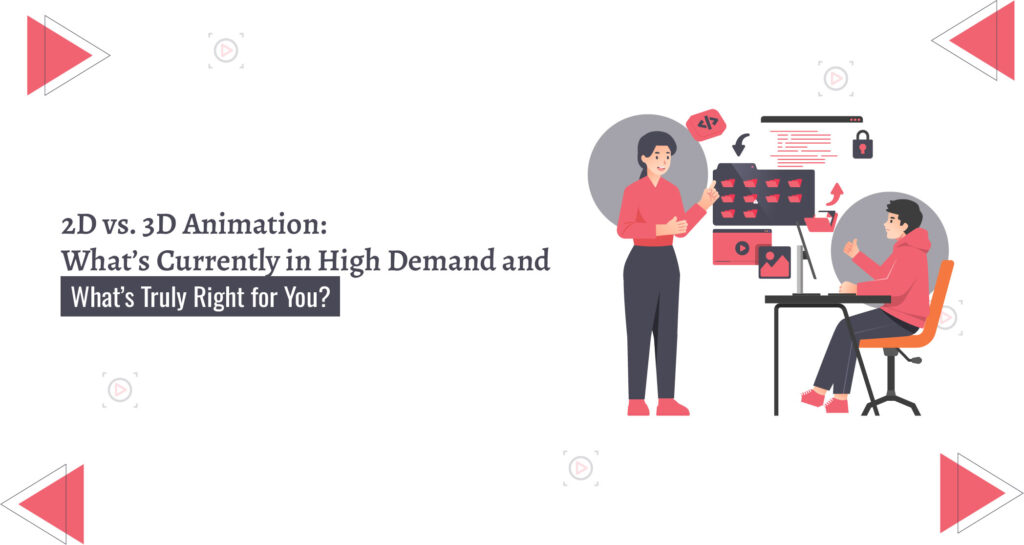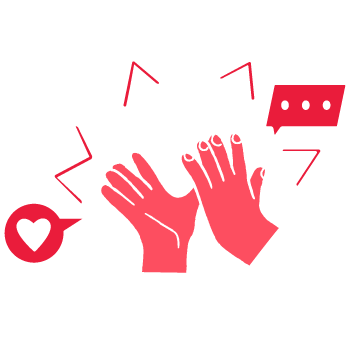
The animation industry is thriving Whether it’s a stunning 2D or 3D animation film, an engaging 2D or 3D animation game, or engaging cartoons, none of it works without talented animators. This is your chance to understand what’s really in demand and where to focus your efforts.
We are witnessing a bright era for animators, now more than ever. It’s no surprise, though. People continue to consume animated content. As long as this appetite for animation remains, animators will not be facing a shortage of job opportunities anytime soon. If we’re talking straight facts, we shouldn’t shy away from saying that the animation business is on the rise. With viewers constantly craving high-quality and immersive visuals, we are becoming more accustomed to consuming videos, especially animated ones.
“Animation is being aggressively used for marketing, generating the best ROI, as claimed by 52% of marketers“
In such a scenario, it’s natural to be curious about the latest trends in the animation world, what’s actually in demand, and where to focus your efforts. Fortunately, you’ve come to the right place.
What is animation?
Before we dive in, let’s make sure we’re all on the same page about what animation is.
At its simplest, animation is the art of making still images look like they’re moving. This illusion is created by showing a series of static images quickly, fast enough that the viewer’s brain interprets them as continuous motion. In the past, animators achieved this by drawing or painting each frame on transparent sheets and then photographing sequentially. Today, most animation is created digitally using computers.
Animation is a key tool for creating visual effects in movies, TV shows, and video games. But its uses go beyond entertainment it’s also used to build interactive experiences, such as online tutorials or virtual reality simulations. For instance, a 3D animation of a car engine can let viewers explore its parts and understand how they work together to power.
The two most popular forms of animation are 2D and 3D. Want to know more about them and how they differ?
Understanding 2D Animation
2D animation, or two-dimensional animation, involves creating characters, environments, and objects in a two-dimensional space. This form of animation has a rich history, dating back to the early days of film and television. Classic examples include Disney’s early films, Looney Tunes, and many anime series.
Key Characteristics:
- Hand-drawn or Vector-based: Traditional 2D animation is hand-drawn, frame by frame. Modern techniques often use vector-based software like Adobe Animate or Toon Boom Harmony.
- Flat Appearance: 2D animations lack depth, giving them a flat look.
- Stylized Designs: 2D animations often have unique, stylized designs that can range from simple and cartoonish to detailed and realistic.
| Pros | Cons |
|---|---|
| Cost-Effective: Generally cheaper and quicker to produce compared to 3D animation. | Limited Perspective: Can’t easily depict intricate camera angles or depth. |
| Simpler Technology: Requires less complex software and hardware. | Labor-Intensive: Traditional frame-by-frame animation can be time-consuming. |
| Artistic Freedom: Offers a wide range of artistic styles and creative expression. |
Understanding 3D Animation
3D animation, or three-dimensional animation, creates characters and environments in a three-dimensional space. This technique is widely used in modern films, video games, and virtual reality.
Key Characteristics:
- Digital Modeling: Characters and objects are modeled in 3D software like Maya, Blender, or 3DS Max.
- Realistic Depth: 3D animations have depth, making them appear more realistic.
- Complex Movements: Capable of intricate movements and camera angles.
| Pros | Cons |
|---|---|
| Realism: Can achieve highly realistic visuals. | Costly: More expensive and time-consuming to produce. |
| Versatility: Suitable for a wide range of applications, including movies, games, and VR. | Complex Technology: Requires advanced software and powerful hardware. |
| Reusable Assets: 3D models can be reused and easily modified. | Learning Curve: Steeper learning curve for animators. |
What are the differences and similarities between 2D and 3D animation?
If you’re wondering which is better between 2D and 3D animation, here’s the answer:
Determining their demand can be challenging. However, we can pinpoint where each excels. 2D animation is widely used in television shows, digital ads, websites, and mobile apps. In contrast, 3D animation is commonly found in video games, architecture, movies, and engineering. It’s not just about creating characters 3D animation has also made its way into trending anime. 2D & 3D animators are now actively involved in creating 3D anime characters.
Does this capture the essence of your original text?
- Entertainment: Both 2D and 3D are popular. 3D dominates in blockbuster films and video games, while 2D remains strong in TV shows, indie films, and anime.
- Advertising: 2D animation is often preferred for its cost-effectiveness and artistic appeal. 3D is used for high-end ads needing realistic visuals.
- Education and Training: 2D is common for explainer videos and educational content. 3D is favored for simulations and interactive training.
- Virtual Reality and Augmented Reality: Predominantly 3D due to the need for immersive experiences.
Here’s an example of 2D animation:
And this one is made with 3D animation:
The Animation Process: Step-by-Step
Creating animation, whether 2D or 3D, involves a series of structured steps that bring characters and stories to life. Here’s a breakdown of the process:
The first step in animation is creating the art assets:
- In 2D animation, this involves drawing characters, backgrounds, and other elements by hand or using digital tools.
- In 3D animation, artists create models and textures to build the characters, objects, and environments in a three-dimensional space.
The second step is animating those assets:
This can be done using software like Adobe After Effects or Autodesk Maya, but the process varies depending on the type of animation:
- In 2D animation, artists manipulate individual images or frames to create movement.
- In 3D animation, artists manipulate objects within a 3D environment, controlling their movements, rotations, and interactions.
The third step is compositing the animation:
This involves combining the animated elements with other components like music, sound effects, and visual effects.
- In 2D animation, compositing is typically done during post-production.
- In 3D animation, compositing often happens in real-time, as digital elements like lighting, shadows, and textures are rendered directly into each scene.
Salary Differences Between 2D and 3D Animators:
Salary ranges for animators vary depending on the type of animation they specialize in. Generally, 3D animators earn more due to the high demand for their skills and the complexity of their work.
2D animators typically earn around $67,851 annually.
3D animators can make $84,000 or more per year.
What is 2D Animation?
So, what exactly is 2D animation?
2D animation is the process of creating images and scenes using two-dimensional art. It typically involves hand-drawn illustrations or digital drawings created with computer software. This technique requires an artist to draw each frame individually, which is then compiled and sequenced using software to create the illusion of movement. Famous examples of 2D animation include classic cartoons like The Simpsons and Looney Tunes, as well as modern shows such as Adventure Time and Rick and Morty.
Like any creative medium, 2D animation has its advantages and disadvantages. Let’s explore them.
Pros and Cons of 2D Animation:
The pros of 2D animation include:
- It requires fewer resources and is generally more cost-effective.
- It has a shorter production timeline compared to other animation styles.
- It offers the flexibility to create a wide range of visual styles, from simplistic to highly detailed.
On the other hand, the cons of 2D animation are:
- It can be a time-consuming process, especially when drawing each frame by hand.
- Depending on the complexity, it can become expensive compared to other animation techniques.
- It’s more challenging to achieve realistic effects and movements compared to 3D animation.
2D Animation Techniques and Software:
There are several key techniques used in 2D animation:
- Traditional Animation (Cel Animation):
This is the classic form of 2D animation, where each frame is drawn by hand on transparent sheets (cels) and then photographed in sequence. It allows for a high level of detail and artistic expression. - Rotoscoping:
In this technique, artists trace live-action footage frame by frame to create realistic animated movements. This is often done using a lightbox or digital tablet. - Stop Motion:
While not exclusive to 2D, stop motion can be used in a 2D context by photographing drawings or cutouts in slightly different positions to simulate motion. It’s one of the most time-intensive methods of animation.
The most popular 2D animation software programs include:
- Adobe Animate
- Toon Boom Harmony
- TV Paint
The cost of these programs varies depending on their features and capabilities. Many offer free trial versions, allowing you to test them before committing.
What is 3D Animation?
3D animation involves creating computer-generated images (CGI) to build animated scenes within a three-dimensional environment. This allows characters and objects to move and interact in a way that mimics real-life depth. Unlike 2D animation, which works on a flat plane, 3D animation adds an extra dimension, giving the illusion of depth, volume, and perspective.
Like 2D animation, 3D animation also comes with its own set of advantages and challenges. Let’s break them down.
Pros and Cons of 3D Animation:
The pros of 3D animation include:
- It can create highly realistic images and characters while remaining cost-effective and time-efficient compared to traditional methods.
- It allows for easier manipulation of scene elements, giving animators greater creative control over the final product.
- It provides a wider range of motion and depth, making it ideal for creating lifelike effects and movements.
On the flip side, the cons of 3D animation are:
- The software required can be complex and challenging to learn, often requiring specialized training.
- Animators need a strong understanding of 3D space and modeling to create realistic animations.
- Making updates or modifications can be difficult once the animation is completed, as changes often require reworking entire scenes.
3D Animation Techniques and Software:
3D animation relies on several key techniques:
- Keyframe Animation:
This is the foundation of 3D animation, where an artist defines specific frames (keyframes) to mark the start and end points of movement. The computer then interpolates the frames in between to create smooth motion. - Motion Capture:
This technique uses live-action footage to record real movements, which are then applied to 3D models. It’s widely used in films and video games to achieve realistic character animations. - Rigging:
Rigging involves creating a digital skeleton for a 3D model, allowing animators to control its movements. This skeleton is often paired with inverse kinematics, a method that automates the movement of limbs and joints for more natural motion.
Popular 3D animation software programs include:
- Autodesk Maya
- Blender
- Cinema 4D
- ZBrush
These tools vary in complexity and cost, but many offer free or trial versions for beginners to explore.
Should You Learn 2D or 3D Animation?
The simple answer is both:
If you’re looking to build a career in animation, learning both 2D and 3D animation is highly recommended. Why? Because they equip you with two distinct yet equally valuable skill sets.
- 2D animation is ideal for creating cartoons and stylized visuals. It’s also more straightforward to learn, making it a great starting point before diving into the more complex world of 3D animation.
- 3D animation, on the other hand, excels at creating realistic visuals. However, it requires more technical expertise, such as understanding how to create realistic lighting, textures, and shadows.
By mastering both, you’ll have a versatile skill set that opens up a wide range of opportunities in the animation industry.
Which is Better – 2D or 3D Animation?
When it comes to 2D vs. 3D animation, neither is inherently better than the other. The choice depends on the project requirements, desired output, and budget.
- 2D animation is perfect for achieving a stylized look with lower production costs, though it may lack the detail and realism of 3D.
- 3D animation can produce highly detailed and lifelike visuals, but it often comes with higher production costs.
Ultimately, the decision comes down to the specific needs of the project and the creative vision you’re aiming to achieve.
Which is Harder – 2D or 3D Animation?
Again, it’s not about one being harder than the other they’re just different.
- 2D animation involves creating individual frames and sequencing them to create movement. It emphasizes artistic skills like drawing and character design.
- 3D animation is more technical, requiring knowledge of modeling, rigging, and computer programming to bring three-dimensional objects and characters to life.
Regardless of the style, animators should be proficient in industry-standard software like Adobe After Effects and Autodesk Maya. Additionally, a creative eye and strong collaboration skills are essential for success.
Should You Learn 2D or 3D Animation First?
Deciding whether to start with 2D or 3D animation is a personal choice and depends on your interests and goals.
- 2D animation is often recommended as a starting point because it has a gentler learning curve and requires less expensive hardware and software. It’s also more accessible for those with a creative mindset.
- 3D animation is more advanced and technical, making it a better fit for those interested in the more rigorous aspects of animation.
Ultimately, the choice is yours. Whichever path you choose, be prepared to invest time and effort to develop your skills.
Useful Tips and Advice
2D animation has endured technical advancements over the decades, ensuring its presence in the future. However, 3D animation tells a whole different story. It has recently gained popularity. There is no doubt that it is worth improving today, that’s for sure.
But then again, the question remains “Will it be there in the future too?
We may or may not witness the same level of enthusiasm for 3D animation in the future. However, the trend for 2D animation is promising. It will become increasingly sophisticated and inventive with improved visuals.
Final Thoughts
As you conclude this blog, courtesy of Animotions Studio, you now grasp the significant differences between 2D and 3D animation, what the current trends demand, and where your focus should lie.
The animation landscape has evolved immensely, from traditional 2D to dynamic 3D modeling, and continues to advance. There’s no harm in learning both 2D and 3D techniques, as both offer valuable skills and potential monetary rewards. Offering video animation services remains a viable career path with promising prospects for the future and beyond, especially through Animotions Studio.
Frequently Asked Questions (FAQ’s)
What is animation?
Animation is the process of creating the illusion of motion and change by rapidly displaying a sequence of static images that differ slightly from each other. This technique brings characters, objects, and environments to life in various forms of media.
What are the different types of animation?
There are several types of animation, including:
- 2D Animation: Traditional hand-drawn animation or vector-based animation.
- 3D Animation: Computer-generated imagery (CGI) creates three-dimensional objects and environments.
- Stop Motion Animation: Physical objects are manipulated and photographed in small increments to create movement.
- Motion Graphics: Animation combined with graphic design, often used in title sequences, advertisements, and explainer videos.
What software do animators use?
Animators use a variety of software tools depending on their animation style:
- 2D Animation: Adobe Animate, Toon Boom Harmony, TVPaint.
- 3D Animation: Autodesk Maya, Blender, Cinema 4D.
- Motion Graphics: Adobe After Effects.
What skills do you need to be an animator?
Essential skills for animators include:
- Artistic Ability: Drawing skills, understanding of composition, color, and form.
- Technical Proficiency: Familiarity with animation software and digital tools.
- Creativity: Ability to develop unique ideas and bring characters to life.
- Attention to Detail: Patience for frame-by-frame work and precision.
- Collaboration: Often work with teams including directors, artists, and sound designers.
Is animation a good career choice?
Yes, animation can be a rewarding career for those passionate about visual storytelling and creativity. It offers opportunities in film, television, advertising, gaming, education, and more. As technology advances, demand for skilled animators continues to grow.





